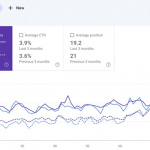
Case Study: Driving Growth For A UK Moving Company
June 5, 2024
Mastering Search Intent for Accountancy: The Ultimate Guide
June 13, 2024Why Optimising For Search Intent Matters

In the constantly changing world of SEO, the focus has shifted from merely targeting keywords to understanding and optimising for search intent. This shift is driven by advancements in search engine algorithms, primarily powered by artificial intelligence, which aim to deliver the most relevant results to users. By rethinking your keyword strategy to prioritise search intent, you can create more effective content that meets user needs, ultimately driving higher engagement and conversions.
Key Takeaways
-
Understanding search intent is crucial for creating content that meets user needs and drives conversions.
-
Search engines now prioritise context and intent over individual keywords, making traditional SEO strategies less effective.
-
Different types of search intent, such as informational, navigational, and transactional, require tailored content approaches.
-
Utilising tools and techniques to identify and optimise for search intent can significantly improve your SEO performance.
-
Balancing keyword relevance, search volume, and competition is essential for a successful intent-driven SEO strategy.
The Evolution of Search Engines
Search engines have come a long way from their early days of merely identifying and ranking pages based on keyword frequency. Modern search engines like Google use sophisticated algorithms to understand the context and intent behind users' queries. This advancement demands a parallel evolution in SEO strategies—particularly the approach to keyword research and optimisation.
Prioritising Search Intent for Effective SEO
When it comes to SEO, prioritising search intent over keywords leads to more effective content that speaks directly to your audience's needs and increases conversion rates. Understanding the different types of search intent is crucial for crafting content that truly resonates with users.
Understanding Different Types of Search Intent
Search intent refers to the purpose behind a user's query. It can generally be categorised into four types:
-
Informational Intent: Users are looking for information or answers to their questions.
-
Navigational Intent: Users are trying to find a specific website or page.
-
Transactional Intent: Users are looking to make a purchase or complete a transaction.
-
Commercial Investigation: Users are researching products or services before making a decision.
Why Search Intent Matters More Than Keywords
The impact of search intent on SEO is profound. By focusing on what users are actually looking for, rather than just the keywords they use, you can create content that is more relevant and engaging. This not only improves user satisfaction but also boosts your search engine rankings.
Prioritising search intent over keywords leads to more effective content that speaks directly to your audience's needs and increases conversion rates.
Tools to Identify Search Intent
There are several tools available to help you identify search intent:
-
Google Analytics (GA4): Provides insights into user behaviour and the types of queries that lead to your site.
-
SEMrush: Offers keyword analysis and helps identify the intent behind search queries.
-
Ahrefs: Another powerful tool for keyword research and understanding search intent.
Using these tools, you can better understand what your audience is looking for and tailor your content accordingly.
Steps to Align SEO with Search Intent
Aligning your SEO strategy with search intent is crucial for driving relevant traffic and improving user engagement. Here are the steps to get you started:
Conducting Intent-Focused Keyword Research
The first step in aligning your content with user intent is to conduct deep research on the search query and keyword. Customer research before keywords is essential. Use customer insights gleaned from conversations, social media, and sales calls to get a grasp on their search behaviour and intent. This should guide the subsequent keyword selection process.
Creating Content that Matches User Intent
Once you've identified the search intents, tailor your content to meet these needs. This means not just focusing on keywords but also on the context and purpose behind those keywords. For example, if users are looking for "how to master SEO search intent to improve your rankings," your content should provide comprehensive, actionable steps to achieve this.
Measuring the Success of Intent-Based SEO
To ensure your strategy is working, you need to measure its success. Use analytics tools to track metrics like user engagement, bounce rates, and conversion rates. These will give you insights into how well your content is meeting user intent and where you might need to make adjustments.
Understanding and leveraging user behaviour is essential for SEO success. In a time where user expectations and search engine algorithms constantly evolve, an approach rooted in user intent is not just a strategic advantage but a necessity.
Case Study: Bank Offering Donor-Advised Funds
Identifying the Search Intent
When we first started working with a bank offering donor-advised fund (DAF) accounts, we noticed they were targeting the keyword "donor-advised fund." While this keyword is broadly relevant, it didn't align well with user intent. Most searchers were merely seeking information rather than expressing an intent to open an account. Shifting the focus to keywords like "how to open a donor-advised fund account" could engage users ready to take that step, thus improving conversion rates.
Tailoring Content to Meet User Needs
We did some research and found that users were looking for:
-
General information about DAFs.
-
A CPA who understands DAFs.
-
How to file their DIY tax return with a DAF.
-
A donor-advised fund account.
The bank should target searchers looking to open a donor-advised fund account. These keywords are searched by people who intend to open a DAF account. Instead, the vast majority of the searches the bank wanted to target had no intention of opening an account.
It’s time to modernise SEO methods, including keyword research, developed for the first generation of search engines.
Results and Learnings
After shifting the focus to intent-driven keywords, the bank saw a significant improvement in conversion rates. Users who searched for "how to open a donor-advised fund account" were more likely to take actionable steps, leading to higher engagement and account openings. This case study highlights the importance of aligning SEO strategies with user intent to achieve better business outcomes.
Balancing Relevance, Volume, and Competition
When it comes to SEO, balancing relevance, volume, and competition is crucial. Let's dive into how to find, choose, and use the right keywords effectively.
Finding the Right Keywords
First, ensure the selected keywords are closely related to your content and offerings. For instance, if you provide eco-friendly cleaning services, target keywords such as "organic cleaning services" rather than just "cleaning services." This ensures that your keywords are not only relevant but also specific to what you offer.
Evaluating Keyword Difficulty
While search volume shouldn't be the sole criterion, it still matters. A balanced strategy would consider medium to high-volume keywords with relevant intent. Competitive keyword analysis is a strategic SEO practice that can offer powerful insights into industry trends and areas of untapped potential. By studying the competition, you can identify which keywords are worth targeting and which ones might be too difficult to rank for.
Balancing Short-Tail and Long-Tail Keywords
High-volume keywords might attract numerous visitors, but if these visitors are not interested in your product or service, they will not convert. This is where the balance between short-tail and long-tail keywords comes into play. Short-tail keywords are often more competitive and have higher search volumes, but they may not always align with the searcher's intent. On the other hand, long-tail keywords are more specific and often have lower search volumes, but they can attract more qualified traffic.
Prioritising intent is crucial for attracting qualified traffic more likely to convert into customers.
In summary, while it's important to consider keyword relevance, volume, and competition, this approach can sometimes mislead you and blunt your SEO campaign's targeting. Always keep the searcher's intent in mind to ensure your efforts are effective.
Re-Evaluating Traditional SEO Strategies
SEO used to focus on keywords and backlinks heavily. Today, however, search intent has become a cornerstone of SEO practices. Websites that successfully interpret the intent behind user queries and deliver on those expectations stand out and are rewarded by search engines with higher rankings and increased visibility.
The Shift from Keywords to Intent
For years, we have relied on keyword research to choose specific searches to target. However, keyword research often prioritises the wrong goals. Executed well, keyword research helps you craft a balanced keyword strategy for your target market and personas. It prioritises keywords that attract traffic that converts into customers. But now, the focus has shifted to understanding the intent behind those keywords.
Common Pitfalls in Traditional SEO
One of the biggest mistakes in traditional SEO is ignoring the user's intent. Many websites still stuff their content with keywords without considering what the user is actually looking for. This approach can lead to high bounce rates and low engagement. Another pitfall is over-relying on backlinks. While a nice backlink here or there never hurt, it's not a substitute for understanding and meeting user intent.
Adapting to Modern SEO Practices
To adapt to modern SEO practices, you need to focus more on user experience and intent. This means creating content that answers the questions users are asking and provides value. It also means using technologies like AI to better understand and predict user behaviour. By prioritising search intent, you ensure that your content not only attracts traffic but also engages and converts the right audience.
Optimising for search intent is critical, but a nice backlink here or there never hurt.
User Experience (UX) and Search Intent
The relationship between UX and search intent is foundational to successful website design. By creating a user-centric web experience that aligns with the intent behind search queries, websites can significantly improve user satisfaction and, as a result, achieve better SEO outcomes.
The Connection Between UX and SEO
User Experience (UX) is integral to modern web design and development. It’s not just about creating a website that looks good; it’s about constructing a site that responds to and satisfies the underlying intent of the user’s search query. When users land on a page, they have expectations, goals, and needs. It’s the job of UX designers and website owners to anticipate and fulfil these as efficiently and effectively as possible.
Designing for User Intent
By analysing search intent, websites become better equipped to serve users exactly what they’re looking for, resulting in a positive user experience and stronger brand loyalty. Embracing the principles of UX and CRO within the scope of search intent ensures that users not only find your site but also take the desired actions once they arrive.
Improving UX to Boost SEO
Staying abreast of the evolution of search algorithms means adapting your content to accommodate new ways users search, like voice search and AI-driven queries. The impact of search intent on SEO is undeniable, and improving UX is a critical step in optimising for it.
Tools and Techniques for Search Intent Optimisation
Keyword Research Tools
Various tools can assist you in dissecting search intent. From Google's own 'People Also Ask' and 'Related Searches' features to third-party tools like Answer the Public and SEMrush, SEO experts have a wealth of resources at their disposal. These tools help you understand what users are looking for and why they are searching for it.
Content Creation Strategies
Focusing on intent has benefits beyond just lifting rankings and traffic. Well-targeted SEO campaigns deliver content and brand messaging to prospects actively researching a purchase. Precise campaign targeting improves conversion. Here are some strategies to consider:
-
Customise your call-to-actions (CTAs) and page layout to serve the predominant search intent for each page.
-
Use surveys and feedback tools to understand if your content truly meets user expectations based on their search queries.
-
Regularly test different versions of your pages to find the most effective elements that resonate with your audience’s search intent.
Analytics and Tracking Tools
Analysing click-through rates (CTRs) and bounce rates via analytics platforms such as Google Analytics can offer insights into whether your content meets the user’s intent. These metrics help you gauge the effectiveness of your content and make necessary adjustments.
Future Trends in Search Intent Optimisation
The Growing Importance of Voice Search
Voice search is becoming increasingly prevalent, and it's changing the way we think about SEO. With more people using voice-activated devices, understanding and optimising for voice search is crucial. This means focusing on natural language and conversational queries. For instance, instead of targeting "best pizza Middlesbrough," you might optimise for "Where can I find the best pizza in Middlesbrough?"
AI and Machine Learning in SEO
Artificial Intelligence (AI) and Machine Learning are revolutionising SEO. These technologies help search engines better understand user intent and deliver more relevant results. By leveraging AI, we can predict trends and adapt our strategies accordingly. This includes using AI-powered tools for Keyword Research and content creation.
Preparing for the Future of Search
The future of search is all about aligning with user intent. As search engines become more sophisticated, they will continue to prioritise user experience. This means creating content that is not only relevant but also engaging and valuable. To stay ahead, we need to continuously learn and adapt to these changes.
The current trajectory of search engines is clear: they’re advancing towards an even deeper understanding of intent, aiming to provide searchers with the most relevant, helpful, and contextually appropriate results.
As we look ahead, the future of search intent optimisation is set to revolutionise how businesses connect with their audience. Staying ahead of these trends is crucial for maintaining a competitive edge. Discover how our expert SEO services can help you navigate these changes and achieve outstanding results. Get in touch for a free SEO audit and start optimising your search strategy today!
Conclusion: Embrace the Future of SEO
In the ever-evolving world of SEO, optimising for search intent is no longer optional—it's essential. By rethinking your keyword strategy to prioritise the 'why' behind user searches, you can create more relevant, engaging, and conversion-focused content. This approach not only aligns with current best practices but also prepares your content for future shifts in search engine algorithms. Embrace this intent-driven strategy to ensure your SEO efforts are both effective and sustainable, ultimately leading to higher rankings, increased visibility, and better user satisfaction.
Frequently Asked Questions
What is search intent?
Search intent refers to the reason behind a user's search query. It focuses on understanding what the user is looking to accomplish with their search.
Why is optimising for search intent important?
Optimising for search intent is important because it helps create content that meets the specific needs of users, leading to higher engagement and conversion rates.
How does search intent differ from keywords?
While keywords are the specific terms users type into search engines, search intent delves into the purpose behind those keywords, aiming to understand the user's ultimate goal.
What are the different types of search intent?
The different types of search intent include informational (seeking information), navigational (looking for a specific website), transactional (aiming to make a purchase), and commercial investigation (researching products or services before buying).
How can I identify search intent for my audience?
You can identify search intent by analysing the search queries your audience uses, studying user behaviour on your site, and using tools like Google Analytics and keyword research tools to gain insights.
What tools can help with search intent optimisation?
Tools that can help with search intent optimisation include Google Analytics, SEMrush, Ahrefs, Moz, and specialised keyword research tools that offer insights into user intent.
How do I create content that matches user intent?
To create content that matches user intent, start by understanding the specific needs and goals of your audience, then tailor your content to address those needs directly and comprehensively.
How can I measure the success of intent-based SEO?
You can measure the success of intent-based SEO by tracking metrics such as user engagement, conversion rates, bounce rates, and the overall performance of your content in search engine rankings.

The best place to hide a dead body is the second page of Google.
After years of experience in larger agencies, we noticed a significant gap in the market for smaller companies and startups that didn't have a massive budget to allocate towards SEO. Many SMEs and startups understand the importance of SEO but find the barrier to entry too high.
Free SEO Audit
Get in touch now for a free audit for your website. We offer free advise on how you can gain the most visibility for your website, even if you choose not to come on board moving forward.

